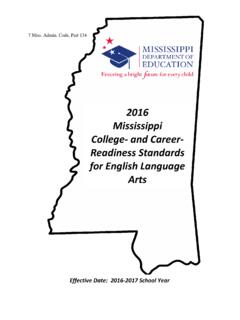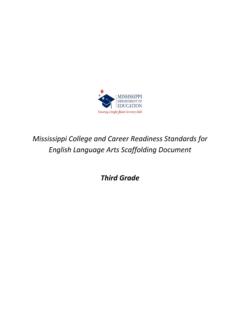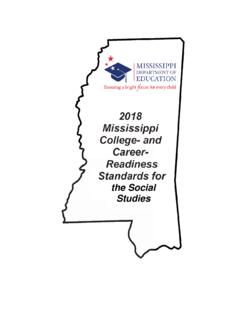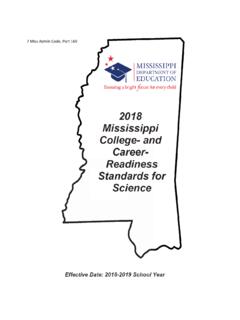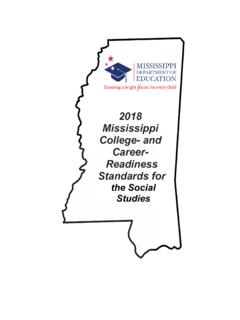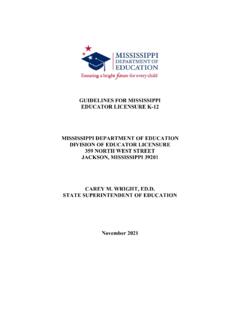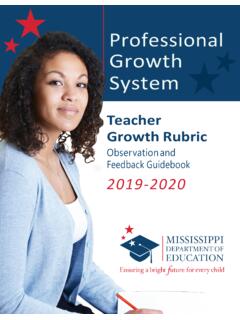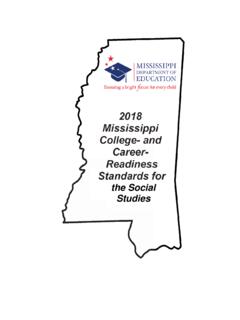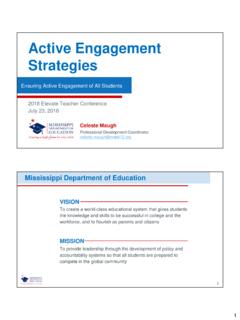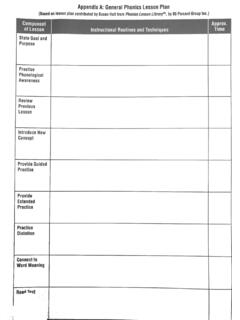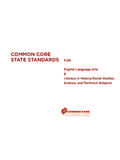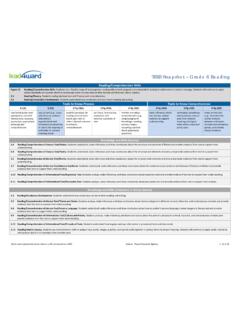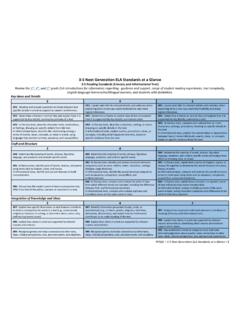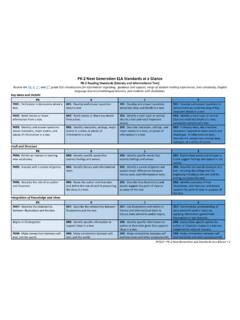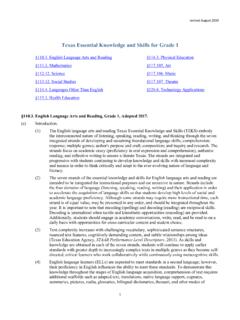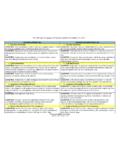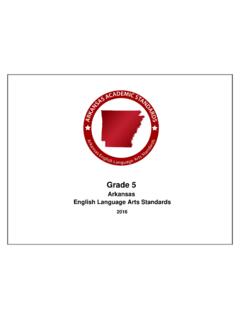Transcription of First Grade - Mississippi Department of Education
1 Mississippi College and Career Readiness Standards for English Language Arts Scaffolding Document First Grade College- and Career-Readiness Standards for English Language Arts Page 2 of 77-September 2016 First Grade : Read closely to determine what the text says explicitly and make logical inferences from it; cite specific textual evidence and when writing or speaking to support conclusions drawn from the text. Ask and answer questions about key details in a text. Desired Student Performance A student should know (Prerequisite Knowledge) There is a difference between a telling sentence and an asking sentence. Key words ( , who, what, when, etc.) signal a question is being asked. A key detail is a statement in a text that helps the reader better understand what is read.
2 Identify key words within a question. How to participate in conversations that are grounded in text. How to visualize information to ask and answer questions. A student should understand (Conceptual Understanding) Growing readers learn to ask questions before, during, and after reading to gain meaning from what is read. Growing readers ask and answer questions within the text (right there) to make and clarify meaning. Growing readers begin to understand that many of their questions may not be answered in the text. They will need to infer using word and picture clues from the text and use the clues to cite evidence from the text. Growing readers monitor their comprehension in literary text by asking themselves appropriate questions when they read.
3 A student should be able to do (Evidence of Knowledge) Listen to or read a text then ask or answer questions about the characters, setting, and plot ( , beginning, middle, end, problem, and solution) of the text using question words ( , who, what, when, where, why, and how). Find the answers to questions about key details in the text regarding narrative elements, and record answers in a variety of formats ( , graphic organizer, sticky notes, two column notes, jotting on text). Use clues in the text to answer inferential questions ( , predict, infer, or draw a conclusion) and be able to justify the answer based on the clues. KEY LANGUAGE/VERBS/TERMS RELATED TO THE STANDARD: question, answer, literary text, visualize, infer, read closely, before, during, after, key details, predict, infer, draw conclusion College- and Career-Readiness Standards for English Language Arts Page 3 of 77-September 2016 First Grade : Determine central ideas or themes of a text and analyze their development; summarize the key supporting details and ideas.
4 Retell stories, including key details, and demonstrate understanding of their central message or lesson. Desired Student Performance A student should know (Prerequisite Knowledge) How to stop and think about one s own thinking when listening to a read aloud or reading independently. How to identify the major characters, setting, problem, and solution from a text. How to cite basic story elements within a story to explain thinking. Details are pieces of information that help the reader understand what they are reading . How to determine key details for the beginning, middle, and end. Sometimes authors use a story to teach a lesson. A student should understand (Conceptual Understanding) Authors write stories that can teach lessons or send a message.
5 This sometimes applies to readers own lives. The central message or lesson of a story is something the author is trying to teach in the story. Often in a story, the characters learn a lesson through their actions. Retelling a story helps the reader have greater understanding of the story and assists in determining the message or theme. Readers synthesize key points made by the author to determine the central message or theme. A student should be able to do (Evidence of Knowledge) Provide a retelling of a story, including key details such as what happened at the beginning, middle, and end of the story. When retelling a story, tell about the character, setting, plot, problem/solution, and/or the message or lesson of a story. Identify the central message or lesson in a text.
6 O What did the character learn in the story? KEY LANGUAGE/VERBS/TERMS RELATED TO THE STANDARD: detail, lesson, message, retelling, reflect on thinking, narrative text elements, characters, setting, plot, problem and solution College- and Career-Readiness Standards for English Language Arts Page 4 of 77-September 2016 First Grade : Analyze how and why individuals, events, or ideas develop and interact over the course of a text. Describe characters, settings, and major events in a story, using key details. Desired Student Performance A student should know (Prerequisite Knowledge) How to identify characteristics of a familiar story: characters, a setting, a problem, and a solution. A character is a person or creature in a story.
7 A major event is where something important happens in the story. The setting is when and where a story takes place. A key detail is a statement in the text that helps the reader understand the text. A student should understand (Conceptual Understanding) Authors provide key details in a story to share information about characters, the setting, and major events. Growing readers look for key details in a text that help the reader have greater understanding of what is happening in the story. Growing readers pay attention to the text to see how the author describes a character s feelings, actions, thoughts, and interactions with other characters. Growing readers analyze and describe the details that impact the major events within the story.
8 Growing readers look for details that describe the setting of a story. A student should be able to do (Evidence of Knowledge) Describe characters in a story using key details from the story such as how the character feels, what the character looks like, or how the character interacts with other characters. Describe the setting of a story using key details from text to tell information about the setting such as where and when the story takes place. Provide a description of the major events in a story using key details by retelling the story in sequence. Complete a graphic organizer such as a story map. Describe or graphically represent the characters, setting, and major events in a story using key details. KEY LANGUAGE/VERBS/TERMS RELATED TO THE STANDARD: character, setting, major event, key detail, interactions, traits, describe College- and Career-Readiness Standards for English Language Arts Page 5 of 77-September 2016 First Grade : Interpret words and phrases as they are used in a text, including determining technical, connotative, and figurative meanings, and analyze how specific word choices shape meaning or tone.
9 Identify words and phrases in stories or poems that suggest feelings or appeal to the senses. Desired Student Performance A student should know (Prerequisite Knowledge) Feelings are emotions and attitudes. How to identify feelings evoked from the text. How to interpret word context by using picture clues. How to explain simple figurative language ( , simile, metaphor) The five senses are sight, hear, smell, touch, and taste. A student should understand (Conceptual Understanding) Authors choose their words carefully to create a piece of writing that appeals to the reader s emotions. Thinking about how characters feel helps the reader make connections to the text. Growing readers actively seek to make meaning of unknown words and phrases to clarify their understanding.
10 Authors chose language that creates mental images in the reader s mind to enhance deep understanding. A student should be able to do (Evidence of Knowledge) Recognize that words and phrases have literal and nonliteral meanings. Identify words and phrases that suggest feelings or emotions using clues from the text. Use clues from the text to identify words and phrases in stories or poems that appeal to the senses ( , sight, touch, taste, smell, and hearing). KEY LANGUAGE/VERBS/TERMS RELATED TO THE STANDARD: words, phrases, feelings, emotions, senses, mental images, infer, draw conclusions, monitor comprehension, poems, figurative language College- and Career-Readiness Standards for English Language Arts Page 6 of 77-September 2016 First Grade : Analyze the structure of texts, including how specific sentences, paragraphs, and larger portions of the text ( , a section, chapter, scene, or stanza) relate to each other and the whole.
